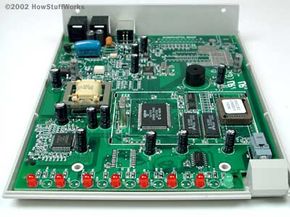Modem Technology
In order to create faster modems, modem designers had to use techniques far more sophisticated than frequency-shift keying. First they moved to phase-shift keying (PSK), and then quadrature amplitude modulation (QAM). These techniques allow an incredible amount of information to be crammed into the 3,000 hertz of bandwidth available on a normal voice-grade phone line. 56K modems, which actually connect at something like 48 Kbps on anything but absolutely perfect lines, are about the limit of these techniques (see the links at the end of this article for more information).
All of these high-speed modems incorporate a concept of gradual degradation, meaning they can test the phone line and fall back to slower speeds if the line cannot handle the modem's fastest speed.
Advertisement
The next step in the evolution of the modem was asymmetric digital subscriber line (ADSL) modems. The word asymmetric is used because these modems send data faster in one direction than they do in another. An ADSL modem takes advantage of the fact that any normal home, apartment or office has a dedicated copper wire running between it and phone company's nearest mux or central office. This dedicated copper wire can carry far more data than the 3,000-hertz signal needed for your phone's voice channel. If both the phone company's central office and your house are equipped with an ADSL modem on your line, then the section of copper wire between your house and the phone company can act as a purely digital high-speed transmission channel. The capacity is something like 1 million bits per second (Mbps) between the home and the phone company (upstream) and 8 Mbps between the phone company and the home (downstream) under ideal conditions. The same line can transmit both a phone conversation and the digital data.
The approach an ADSL modem takes is very simple in principle. The phone line's bandwidth between 24,000 hertz and 1,100,000 hertz is divided into 4,000-hertz bands, and a virtual modem is assigned to each band. Each of these 249 virtual modems tests its band and does the best it can with the slice of bandwidth it is allocated. The aggregate of the 249 virtual modems is the total speed of the pipe.
(For information on the latest DSL technology, see How DSL Works.)
